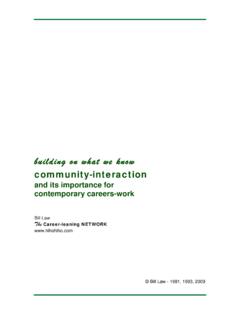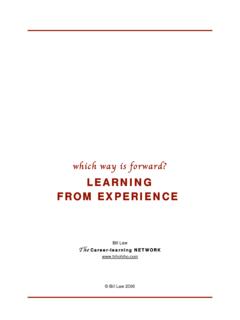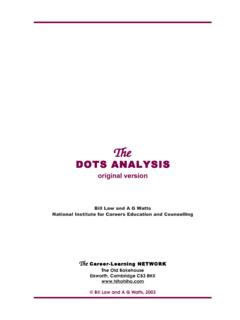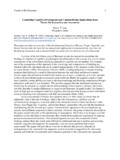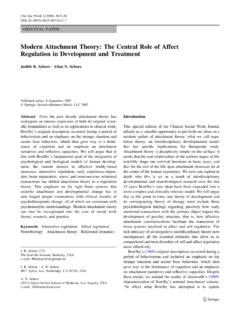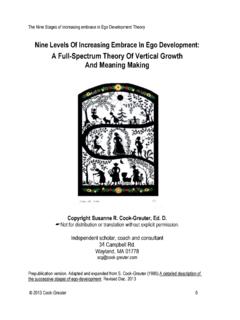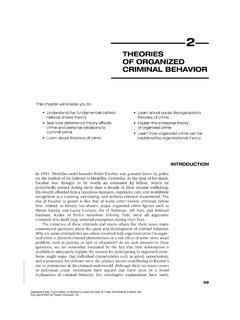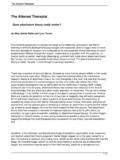Transcription of building on what we know - hihohiho.com
1 building on what we know career learning theory the original article Bill Lawca The Career-learning CAF Bill Law, 1996, 2010 Bill Law (1992, 2010) career-learning theory in A G Watts, Bill Law, John Killeen, Jennifer M Kidd and Ruth Hawthorn Rethinking Careers Education and Guidance - theory , Policy and Practice London: Routledge now free-on-line at an account of critical thinking in career management - thinking-feeling - processing stage-by-stage - leading to readiness for action _____ a companion piece with Bill Law (1981, 2010) community-interaction theory now free on-line at an account of social-emotional influences on career management - how they are experienced in family, neighbourhood and education - what they mean for careers work _____ both are meta-analyses, community interaction signposting influences, learning theory how they are managed learning theory recapitulates scene-setting ideas in the earlier article - desrcibing the thinking to which these new ideas are introduced - this later account adds diagrams, organising the ideas and showing how this this work extends them these (skippable)
2 Scene-setting ideas are on pages 2-5 - boxed in green career-learning theory as a distinct set of ideas begins on page 6 The Career-learning CAF career-learning theory - page 1 There is no shortage of ideas about influences on career. Some are supported by research; many have been incorporated into formal theory . This article takes another look at these ideas, and reconfigures them. The configuration is as a progressively learned sequence of career- development capacities and behaviours. Progression is important for two related reasons: 1. it identifies what is 'basic' and what is 'developed' in people's career experience; 2.
3 It indicates how the more basic experiences prepare the ground (or fail to prepare the ground) for later development . This is a matter of some practical importance. Career development is increasingly problematic. Anticipating the consequences of one's own actions is ever more troublesome; plans laid today commonly require adjustment - and, possibly, abandonment - later. Notions of career planning based on a once-and-for-all (or even once-in-a-while) review of the options and priorities are weak because both the options and the priorities will change. The requirement is that people need repeatedly to review career choices and transitions, with thought and care.
4 All of this argues for supporting people through a lifelong process of career-related thinking and rethinking, action and new action. The progression developed in this chapter therefore refers to how people leam to manage their careers. Like all theories, it offers descriptions of what happens; explanations, suggesting why they happen in the way they do; and predictions, anticipating what can happen in what conditions. A strong justification for any career- development theory is its ability, through prediction, to suggest useful models for careers education and guidance. The chapter will first examine similarities and differences between existing career- development theories.
5 It will next present a new career-learning theory , first as a set of ten propositions, and then as a series of four stages and eight sub-stages. Finally, it will locate this theory in relation to existing theories, and explore implications for practice. The Career-learning CAF career-learning theory - page 2 key components in career- development theories Career- development theory is not unitary. It comprises a range of theories, offering a variety of configurations, each offering foreground significance to different aspects of work, role and self. For our present purposes, it is useful to identify four broadly distinguishable clusters: trait-and-factor theories; self-concept theories; opportunity-structure theories; and community-interaction theories.
6 Trait-and-factor theories: Trait-and-factor theories offer foreground significance to specifically identified features of the self, such as abilities or personal orientations. They suggest matching models for careers education and guidance, assuming the usefulness of making a link between particular people and suitable work, for example through structured interviewing and computer-assisted guidance. Much of Rodger's (1952) 'seven-point plan' - with its use of such descriptors as 'aptitude' and 'personality' - relied upon such thinking. Psychometric testing is also based on such assumptions (Kline, 1975), as were some early attempts at profiling.
7 At its simplest this is 'pegs-and-holes' thinking, but it is capable of more sophistication. For example, Dawis (1994) explains satisfactory career development in terms of a person-fit match, taking account of four sets of individual differences: (1) ability; (2) reinforcement values - that is, personal needs, settling over time into stable values; (3) satisfaction by the employee; and (4) person-environment fit - that is, 'harmony with the environment'. Match and mismatch between person and position may, therefore, be dynamic and interactive. self-concept theories: The 'self-concept' connotes a more interactive self, developing through life stages, and - in so doing - experiencing changing motivations and other feelings about work (Super, 1957).
8 Such theories yield more subtle descriptions of an individual, difficult to fit to the ready-made categories of trait-and-factor thinking (Roe, 1951). They emphasise the importance for careers education and guidance of the expression and use of the affective, changing, multi-layered and unique experience of each person (Daws, 1968). A well-defined use of such highly individualised ideas appears in the application to careers education and guidance of personal-construct theory (Edmonds, 1979; Offer, 1995). It suggests counselling models in guidance, and experiential learning in careers education. Some aspects of recording achievement and individual action planning also call upon self-concept theory (Watts, 1991), as do some aspects of computer-assisted guidance (Law, 1994).
9 All invite helpers to work sensitively, in the learner's own terms, seeking bases for the learner's choices and actions. Accommodation of interaction between person and position is found in Gottfredson's (1981) work. She argues that children orientate by stages to: (1) size and social power - noticing the differences between child and adult; (2) sex roles - noticing the differences between masculine and feminine; (3) social valuation - using more abstract concepts to discriminate levels of status and prestige; and (4) internal unique valuation - noticing the differences between me and others in term of interests, abilities and values.
10 These 'selves' are not conceived as growing in a social vacuum. continued/.. The Career-learning CAF career-learning theory - page 3 ../ continued opportunity-structure theories: That social position is an important determinant of career-related life chances is a central feature of opportunity-structure theories. These offer foreground significance to the labour economy and its supporting education-and-training and social structures. People are thought of not so much as choosing work as being chosen for it. They do not need to agonise about what they want because, it is argued, they take what is available to them.


